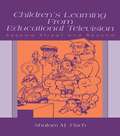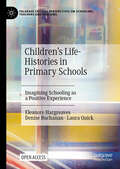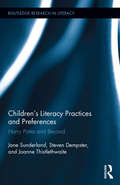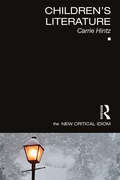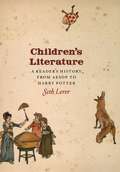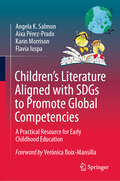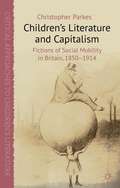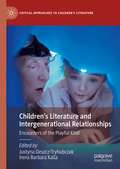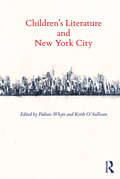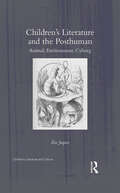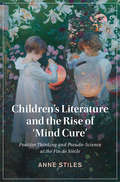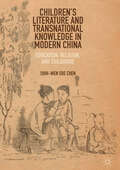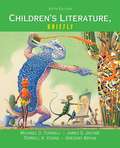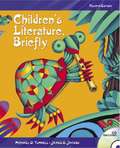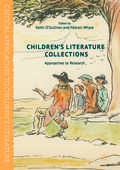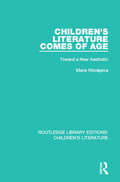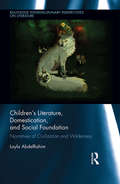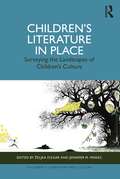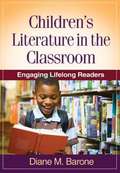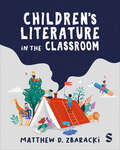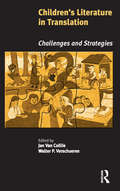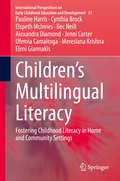- Table View
- List View
Children's Learning From Educational Television: Sesame Street and Beyond
by Shalom M. FischAt its best, educational television can provide children with enormous opportunities and can serve as a window to new experiences, enrich academic knowledge, enhance attitudes and motivation, and nurture social skills. This volume documents the impact of educational television in a variety of subject areas and proposes mechanisms to explain its effects. Drawing from a wide variety of research spanning several disciplines, author Shalom M. Fisch analyzes the literature on the impact of educational resources. He focuses on television programs designed for children rather than for adults, although adult literature is included when it is particularly relevant. In addition, much of the discussion concerns the effects of unaided viewing by children, rather than viewing in the context of adult-led follow-up activities. The role of parent-child co-viewing and issues relevant to the use of television in school or child care also receives consideration. This volume is intended to make the disparate literature on educational television's impact more accessible, by bringing it together into a centralized resource. To that end, the volume draws together empirical data on the impact of educational television programs--both academic and prosocial--on children's knowledge, skills, attitudes, and behavior. In addition to its emphasis on positive effects, this volume addresses a gap in the existing research literature regarding children's learning from exposure to educational television. Acknowledging that little theoretical work has been done to explain why or how these effects occur, Fisch takes a step toward correcting this situation by proposing theoretical models to explore aspects of the mental processing that underlies children's learning from educational television. With its unique perspective on children's educational television and comprehensive approach to studying the topic, this volume is required reading for scholars, researchers, and students working in the area of children and television. It offers crucial insights to scholars in developmental psychology, family studies, educational psychology, and related areas.
Children's Life-Histories in Primary Schools: Imagining Schooling as a Positive Experience (Palgrave Critical Perspectives on Schooling, Teachers and Teaching)
by Eleanore Hargreaves Denise Buchanan Laura QuickThis open access book explores schooling from the perspective of children via data from a longitudinal life-history study. It questions whether schooling creates an environment where all children to flourish; or whether a policy focus on attainment in mathematics and English hinders some children’s wellbeing and learning. By drawing on the children’s life-history narratives and their ideas, the chapters also portray children’s realistic suggestions for practices that meet the needs of diverse children and strengthen their comprehensive wellbeing and learning within schooling.
Children's Literacy Practices and Preferences: Harry Potter and Beyond (Routledge Research in Literacy #8)
by Jane Sunderland Steven Dempster Joanne ThistlethwaiteOver the past few decades there have been intense debates in education surrounding children’s literacy achievement and ways to promote reading, particularly that of boys. The Harry Potter book series has been received enthusiastically by very many children, boys and girls alike, but has also been constructed in popular and media discourses as a children’s, particularly a boys’, literacy saviour. Children’s Literacy Practices and Preferences: Harry Potter and Beyond provides empirical evidence of young people’s reported literacy practices and views on reading, and of how they see how the Harry Potter series as having impacted their own literacy. The volume explores and debunks some of the myths surrounding Harry Potter and literacy, and contextualizes these within children’s wider reading.
Children's Literature (The New Critical Idiom)
by Carrie HintzChildren’s Literature is an accessible introduction to this engaging field. Carrie Hintz offers a defining conceptual overview of children’s literature that presents its competing histories, its cultural contexts, and the theoretical debates it has instigated. Positioned within the wider field of adult literary, film, and television culture, this book also covers: Ideological and political movements Children’s literature in the age of globalization Postcolonial literature, ecocriticism, and animal studies Each chapter includes a case study featuring well-known authors and titles, including Charlotte’s Web, Edward Lear, and Laura Ingalls Wilder. With a comprehensive glossary and further reading, this book is invaluable reading for anyone studying Children’s Literature.
Children's Literature: A Reader's History, from Aesop to Harry Potter
by Seth LererEver since children have learned to read, there has been children's literature. It is inseparable from the history of childhood. The tales they hear and read molds children. They will one day share these with their own children.
Children’s Literature Aligned with SDGs to Promote Global Competencies: A Practical Resource for Early Childhood Education
by Angela K. Salmon Aixa Pérez-Prado Karin Morrison Flavia IuspaThis book presents children’s literature as a platform for learning and helping young readers develop the knowledge, skills, and attitudes needed to thrive in an interconnected and diverse global society. It draws from various theoretical frameworks and research findings to implement critical literacy and culturally responsive teaching in the meaning-making process.The book focuses on global competencies and Sustainable Development Goals (SDGs) as intertwined concepts that work together to foster a more sustainable, inclusive, and equitable world. Developing global competencies empowers children and communities to actively participate in achieving the SDGs and addressing the pressing challenges of our time. The authors set high expectations on children as actors in transforming society. To facilitate this, the book offers an overview of child development theories as a foundation for designing developmentally appropriate practices to extend children’s books toward deep thinking and understanding. The book includes sample lessons that use cutting-edge research-based pedagogies and tools such as visible thinking routines and other approaches. Those lessons also help readers identify the Habits of Mind (HOM) children can develop by listening to and discussing stories. The HOM are attributes of good problem-finders and problem-solvers needed when confronting complex issues. The book provides resources and sample lessons that implement different thinking strategies to engage children in questioning and analyzing what they read, making them more critical. This is how children deeply understand the world and their role in creating positive change. The book aims to cultivate change-makers and global citizens through stories. It offers innovative approaches, including online learning options in accessible and engaging ways to help children think globally and act locally‘Through the power of children’s literature, this book serves a larger agenda: To build a more thoughtful world for future generations. By caring for and learning from one another through suggested activities in this book, they will share the riches and resources from across the world. As children learn about the promise of actions toward the UN Sustainable Goals, they can imagine living in an interdependent learning community where all people continually searching for ways to trust each other, learn together, and grow toward greater intelligence.’ Arthur Costa and Bena Kallick, Co-Founders and Directors of The Institute for Habits of Mind
Children's Literature and Capitalism
by Christopher ParkesAfter the first phase of industrialization in Britain, the child emerged as both a victim of and a threat to capitalism. This book explores the changing relationship between the child and capitalist society in the works of some of the most important writers of children's and young-adult texts in the Victorian and Edwardian periods.
Children's Literature and Culture of the First World War (Children's Literature and Culture)
by Emma Short Lissa Paul Rosemary R. JohnstonBecause all wars in the twenty-first century are potentially global wars, the centenary of the first global war is the occasion for reflection. This volume offers an unprecedented account of the lives, stories, letters, games, schools, institutions (such as the Boy Scouts and YMCA), and toys of children in Europe, North America, and the Global South during the First World War and surrounding years. By engaging with developments in Children’s Literature, War Studies, and Education, and mining newly available archival resources (including letters written by children), the contributors to this volume demonstrate how perceptions of childhood changed in the period. Children who had been constructed as Romantic innocents playing safely in secure gardens were transformed into socially responsible children actively committing themselves to the war effort. In order to foreground cross-cultural connections across what had been perceived as ‘enemy’ lines, perspectives on German, American, British, Australian, and Canadian children’s literature and culture are situated so that they work in conversation with each other. The multidisciplinary, multinational range of contributors to this volume make it distinctive and a particularly valuable contribution to emerging studies on the impact of war on the lives of children.
Children’s Literature and Intergenerational Relationships: Encounters of the Playful Kind (Critical Approaches to Children's Literature)
by Justyna Deszcz-Tryhubczak Irena Barbara KallaChildren’s Literature and Intergenerational Relationships: Encounters of the Playful Kind explores ways in which children’s literature becomes the object and catalyst of play that brings younger and older generations closer to one another. Providing examples from diverse cultural and historical contexts, this collection argues that children’s texts promote intergenerational play through the use of literary devices and graphic formats and that they may prompt joint play practices in the real world. The book offers a distinctive contribution to children’s literature scholarship by shifting critical attention away from the difference and conflict between children and adults to the exploration of inter-age interdependencies as equally crucial aspects of human life, presenting a new perspective for all who research and work with children’s culture in times of global aging.
Children's Literature and New York City (Children's Literature and Culture)
by Pádraic Whyte Keith O’SullivanThis collection explores the significance of New York City in children’s literature, stressing literary, political, and societal influences on writing for young people from the twentieth century to the present day. Contextualized in light of contemporary critical and cultural theory, the chapters examine the varying ways in which children’s literature has engaged with New York City as a city space, both in terms of (urban) realism and as an ‘idea’, such as the fantasy of the city as a place of opportunity, or other associations. The collection visits not only dominant themes, motifs, and tropes, but also the different narrative methods employed to tell readers about the history, function, physical structure, and conceptualization of New York City, acknowledging the shared or symbiotic relationship between literature and the city: just as literature can give imaginative ‘reality’ to the city, the city has the potential to shape the literary text. This book critically engages with most of the major forms and genres for children/young adults that dialogue with New York City, and considers such authors as Margaret Wise Brown, Felice Holman, E. L. Konigsburg, Maurice Sendak, J. D. Salinger, John Donovan, Shaun Tan, Elizabeth Enright, and Patti Smith.
Children's Literature and the Posthuman: Animal, Environment, Cyborg (Children's Literature and Culture)
by Zoe JaquesAn investigation of identity formation in children's literature, this book brings together children’s literature and recent critical concerns with posthuman identity to argue that children’s fiction offers sophisticated interventions into debates about what it means to be human, and in particular about humanity’s relationship to animals and the natural world. In complicating questions of human identity, ecology, gender, and technology, Jaques engages with a multifaceted posthumanism to understand how philosophy can emerge from children's fantasy, disclosing how such fantasy can build upon earlier traditions to represent complex issues of humanness to younger audiences. Interrogating the place of the human through the non-human (whether animal or mechanical) leads this book to have interpretations that radically depart from the critical tradition, which, in its concerns with the socialization and representation of the child, has ignored larger epistemologies of humanness. The book considers canonical texts of children's literature alongside recent bestsellers and films, locating texts such as Gulliver’s Travels (1726), Pinocchio (1883) and the Alice books (1865, 1871) as important works in the evolution of posthuman ideas. This study provides radical new readings of children’s literature and demonstrates that the genre offers sophisticated interventions into the nature, boundaries and dominion of humanity.
Children's Literature and the Rise of ‘Mind Cure': Positive Thinking and Pseudo-Science at the Fin de Siècle (Cambridge Studies in Nineteenth-Century Literature and Culture #126)
by Anne StilesPositive thinking is good for you. You can become healthy, wealthy, and influential by using the power of your mind to attract what you desire. These kooky but commonplace ideas stem from a nineteenth-century new religious movement known as 'mind cure' or New Thought. Related to Mary Baker Eddy's Christian Science, New Thought was once a popular religious movement with hundreds of thousands of followers, and has since migrated into secular contexts such as contemporary psychotherapy, corporate culture, and entertainment. New Thought also pervades nineteenth- and early twentieth-century children's literature, including classics such as The Secret Garden, Anne of Green Gables, and A Little Princess. In this first book-length treatment of New Thought in Anglophone fiction, Anne Stiles explains how children's literature encouraged readers to accept New Thought ideas - especially psychological concepts such as the inner child - thereby ensuring the movement's survival into the present day.
Children’s Literature and Transnational Knowledge in Modern China: Education, Religion, and Childhood
by Shih-Wen Sue ChenThis book examines the development of Chinese children’s literature from the late Qing to early Republican era. It highlights the transnational flows of knowledge, texts, and cultures during a time when children’s literature in China and the West was developing rapidly. Drawing from a rich archive of periodicals, novels, tracts, primers, and textbooks, the author analyzes how Chinese children’s literature published by Protestant missionaries and Chinese educators in the late nineteenth and early twentieth centuries presented varying notions of childhood. In this period of dramatic transition from the dynastic Qing empire to the new Republican China, young readers were offered different models of childhood, some of which challenged dominant Confucian ideas of what it meant to be a child. This volume sheds new light on a little-explored aspect of Chinese literary history. Through its contributions to the fields of children’s literature, book history, missionary history, and translation studies, it enhances our understanding of the negotiations between Chinese and Western cultures that shaped the publication and reception of Chinese texts for children.
Children's Literature, Briefly
by Michael Tunnell James Jacobs Terrell Young Gregory BryanA concise, engaging, practical overview of children’s books that keeps the focus on the books themselves, this brief introduction to children’s literature genres leaves time to actually read children’s books. Written on the assumption that the focus of a children’s literature course should be on the actual books that children read, the authors first wrote this book in 1996 as a “textbook for people who don’t like children’s literature textbooks.” Today it serves as an overview to shed light on the essentials of children’s literature and how to use it effectively with young readers, from PreK to 8th grade.
Children’s Literature, Briefly (4th edition)
by Michael O. Tunnell James S. JacobsAre you looking for a brief introduction to children's literature genres that leaves time to read actual works of children's literature? This new, significantly revised and streamlined edition of Children's Literature, Briefly introduces the reader to the essential foundations of each children's literature genre, supported by practical features and tools to suggest quality books and activities to advance literacy in the classroom. As new teachers build their classroom library, the brevity of this affordable new edition ensures readers have the resources to purchase and time to read actual children's literature. The goal of this text, then, is to provide a practical overview of children's books, offering a framework and background information while keeping the spotlight on the books themselves.
Children's Literature Collections: Approaches to Research (Critical Approaches to Children's Literature)
by Keith O'Sullivan Pádraic WhyteThis book provides scholars, both national and international, with a basis for advanced research in children's literature in collections. Examining books for children published across five centuries, gathered from the collections in Dublin, this unique volume advances causes in collecting, librarianship, education, and children's literature studies more generally. It facilitates processes of discovery and recovery that present various pathways for researchers with diverse interests in children's books to engage with collections. From book histories, through bookselling, information on collectors, and histories of education to close text analyses, it is evident that there are various approaches to researching collections. In this volume, three dominant approaches emerge: history and canonicity, author and text, ideals and institutions. Through its focus on varied materials, from fiction to textbooks, this volume illuminates how cities can articulate a vision of children's literature through particular collections and institutional practices.
Children's Literature Comes of Age: Toward a New Aesthetic (Routledge Library Editions: Children's Literature)
by Maria NikolajevaOriginally published in 1996. A detailed analysis of the art of children's literature covering world literature for children, children's literature as a canonical art form, the history of children's literature from a semiotic perspective, and epic, polyphony, chronotope, intertextuality, and metafiction in children's literature.
Children's Literature, Domestication, and Social Foundation: Narratives of Civilization and Wilderness (Routledge Interdisciplinary Perspectives on Literature)
by Layla AbdelRahimThis study of children's literature as knowledge, culture, and social foundation bridges the gap between science and literature and examines the interconnectedness of fiction and reality as a two-way road. The book investigates how the civilized narrative orders experience by means of segregation, domestication, breeding, and extermination, arguing instead that the stories and narratives of wilderness project chaos and infinite possibilities for experiencing the world through a diverse community of life. AbdelRahim engages these narratives in a dialogue with each other and traces their expression in the various disciplines and books written for both children and adults, analyzing the manifestation of fictional narratives in real life. This is both an inter- and multi-disciplinary endeavor that is reflected in the combination of research methods drawn from anthropology and literary studies as well as in the tracing of the narratives of order and chaos, or civilization and wilderness, in children's literature and our world. Chapters compare and contrast fictional children's books that offer different real-world socio-economic paradigms, such as A.A. Milne's Winnie-the-Pooh projecting a civilized monarcho-capitalist world, Nikolai Nosov's trilogy on The Adventures of Dunno and Friends presenting the challenges and feats of an anarcho-socialist society in evolution from primitivism towards technology, and Tove Jansson's Moominbooks depicting the harmony of anarchy, chaos, and wildness. AbdelRahim examines the construction, transmission, and acquisition of knowledge in children’s literature by visiting the very nature of literature, culture, and language and the civilized structures that domesticate the world. She brings radically new perspectives to the knowledge, culture, and construction of human beings, making an invaluable contribution to a wide range of disciplines and for those engaged in revolutionizing contemporary debates on the nature of knowledge, human identity, and the world.
Children’s Literature in Place: Surveying the Landscapes of Children’s Culture (Children's Literature and Culture)
by Željka Flegar Jennifer M. MiskecChildren’s Literature in Place: Surveying the Landscapes of Children’s Culture is an edited collection dedicated to individual, international, and interdisciplinary considerations of the places and spaces of children’s literature, media, and culture, from content to methodology, in fictional, virtual, and material settings. This volume proposes a survey of the changing landscapes of children’s culture, the expected and unexpected spaces and places that emerge as and because of children’s culture. The places and spaces of children’s literature are varied and diverse. By making place studies a guiding principle, this book builds on the impressive body of international research on place in children’s literature, media, and culture to bring together and provide a comprehensive overview of how to study place in children’s and young adult literature. This volume provides a wide range of approaches and international perspectives of place in children’s literature, media, and culture and contributes to this growing and relevant field by showcasing various scholarly aspects and approaches to children’s literature, and the place of children’s literature in the context of international scholarship.
Children's Literature in the Classroom
by Diane BaroneMany reading programs today overlook an essential component of literacy instruction-helping children develop an enduring love of reading. This authoritative and accessible guide provides a wealth of ideas for incorporating high-quality children's books of all kinds into K-6 classrooms. Numerous practical strategies are presented for engaging students with picture books, fiction, nonfiction, and nontraditional texts. Lively descriptions of recommended books and activities are interspersed with invaluable tips for fitting authentic reading experiences into the busy school day. Every chapter concludes with reflection questions and suggestions for further reading. The volume also features reproducible worksheets and forms.
Children’s Literature in the Classroom
by Matthew D. ZbarackiChildren′s literature is a powerful resource that can inspire a young reader’s lifetime love of reading, but how can you ensure that your literacy teaching uses this rich creative world to its fullest? This book gives pre-service primary teachers an in-depth guide to each major type of children′s book, examining the form, structure and approach of each. From fairy tales and non-fiction to picture books and digital texts, learn what qualities underpin outstanding children′s literature and how you can use this to inspire rewarding learning experiences in your classroom. Key features: Each chapter is full of key book recommendations to help you select excellent age-appropriate texts for your learners An international focus across English-language publishing, covering key books from Australian, US and UK authors A special focus on Australian indigenous children′s literature Busting popular myths about children′s literature to give you a deeper understanding of the form Evaluation criteria for every genre, helping you to recognise the qualities of high quality books This is essential reading for anyone training to teach in primary schools and qualified teachers looking to improve their professional knowledge. Matthew Zbaracki is State Head of Victoria in the National School of Education at ACU, Melbourne.
Children’s Literature in the Classroom
by Matthew D. ZbarackiChildren′s literature is a powerful resource that can inspire a young reader’s lifetime love of reading, but how can you ensure that your literacy teaching uses this rich creative world to its fullest? This book gives pre-service primary teachers an in-depth guide to each major type of children′s book, examining the form, structure and approach of each. From fairy tales and non-fiction to picture books and digital texts, learn what qualities underpin outstanding children′s literature and how you can use this to inspire rewarding learning experiences in your classroom. Key features: Each chapter is full of key book recommendations to help you select excellent age-appropriate texts for your learners An international focus across English-language publishing, covering key books from Australian, US and UK authors A special focus on Australian indigenous children′s literature Busting popular myths about children′s literature to give you a deeper understanding of the form Evaluation criteria for every genre, helping you to recognise the qualities of high quality books This is essential reading for anyone training to teach in primary schools and qualified teachers looking to improve their professional knowledge. Matthew Zbaracki is State Head of Victoria in the National School of Education at ACU, Melbourne.
Children's Literature in the Reading Program, Fifth Edition: Engaging Young Readers in the 21st Century
by Deborah A. Wooten Lauren Aimonette Liang Bernice E. Cullinan Richard L. AllingtonThis indispensable teacher resource and course text, now revised and updated, addresses the "whats," "whys," and "how-tos" of incorporating outstanding children's literature into the K–8 reading program. A strong emphasis on diverse literature is woven throughout the fifth edition, with chapters emphasizing the need for books that reflect their readers and presenting dozens of carefully reviewed books that teachers will be eager to use in the classroom. Leading authorities provide advice on selecting texts, building core literacy and literary skills, supporting struggling readers, and maximizing engagement. The volume offers proven strategies for teaching specific genres and formats, such as fiction, nonfiction, picturebooks, graphic novels, biographies, and poetry. This title is a copublication with the International Literacy Association. New to This Edition *Many new teaching ideas and book recommendations, with an increased focus on culturally diverse literature. *Scope expanded from K–5 to K–8. *Chapter on using read-alouds and silent reading. *Chapters on diverse literature about the arts and on transitional chapter books. *Chapter on engaging struggling readers with authentic reading experiences.
Children's Literature in Translation: Challenges and Strategies (G - Reference, Information And Interdisciplinary Subjects Ser. #2)
by Jan Van Coillie Walter P. VerschuerenChildren's classics from Alice in Wonderland to the works of Astrid Lindgren, Roald Dahl, J.K. Rowling and Philip Pullman are now generally recognized as literary achievements that from a translator's point of view are no less demanding than 'serious' (adult) literature. This volume attempts to explore the various challenges posed by the translation of children's literature and at the same time highlight some of the strategies that translators can and do follow when facing these challenges. A variety of translation theories and concepts are put to critical use, including Even-Zohar's polysystem theory, Toury's concept of norms, Venuti's views on foreignizing and domesticating translations and on the translator's (in)visibility, and Chesterman's prototypical approach. Topics include the ethics of translating for children, the importance of child(hood) images, the 'revelation' of the translator in prefaces, the role of translated children's books in the establishment of literary canons, the status of translations in the former East Germany; questions of taboo and censorship in the translation of adolescent novels, the collision of norms in different translations of a Swedish children's classic, the handling of 'cultural intertextuality' in the Spanish translations of contemporary British fantasy books, strategies for translating cultural markers such as juvenile expressions, functional shifts caused by different translation strategies dealing with character names, and complex translation strategies used in dealing with the dual audience in Hans Christian Andersen's fairy tales and in Salman Rushdie's Haroun and the Sea of Stories.
Children’s Multilingual Literacy: Fostering Childhood Literacy in Home and Community Settings (International Perspectives on Early Childhood Education and Development #31)
by Pauline Harris Cynthia Brock Elspeth McInnes Bec Neill Alexandra Diamond Jenni Carter Ufemia Camaitoga Meresiana Krishna Eleni GiannakisThis book offers a comprehensive report on a three-year, cross-cultural, critical participatory action research study, conducted in children’s homes and communities in Fiji. This project contributed to building sustainable local capacity in communities without access to early childhood services, so as to promote preschool children’s literacy development in their home languages and English. The book includes rich descriptions of the young children’s lived, multilingual literacy practices in their home and community contexts. This work advances research-based practices for fostering young children’s multilingual literacy and building community capacity in a post-colonial Pasifika context; further, it shares valuable insights into processes and complexities that are inherent to multiliteracy and cross-cultural research.
